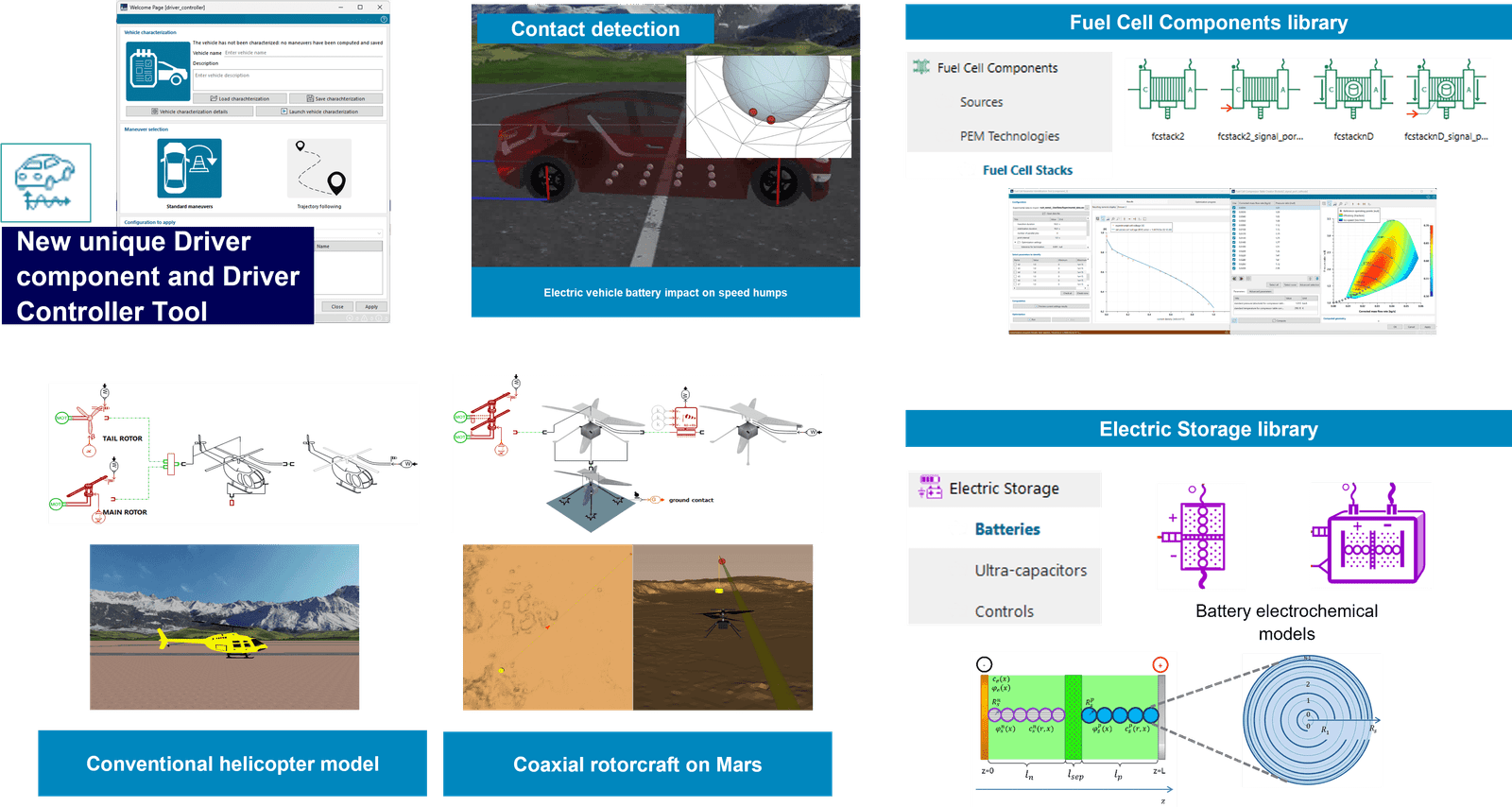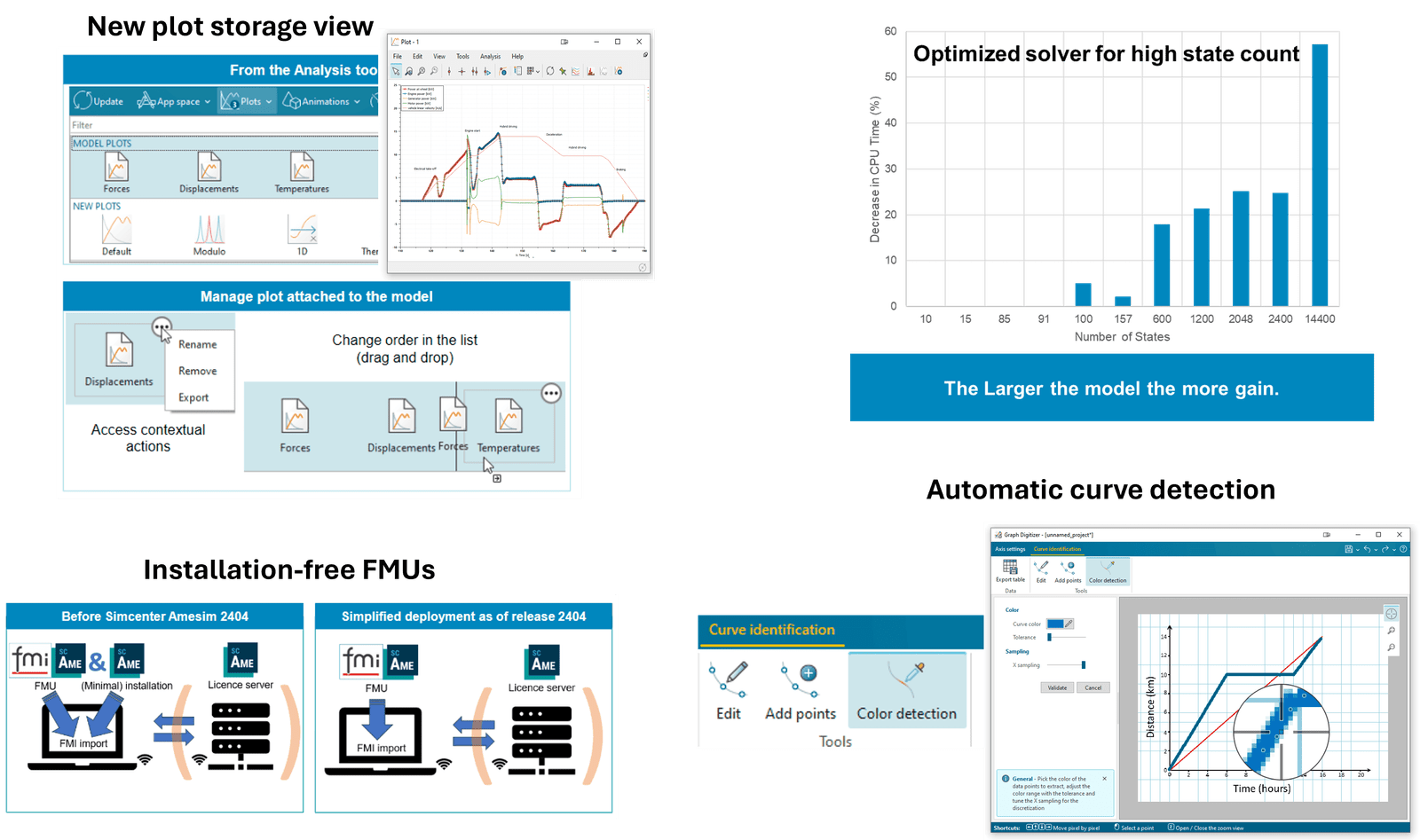The latest Simcenter Amesim version 2404 was released a week ago and contains several new features and updates that increase your simulation productivity and also provides the tools you need to find new insights in your system design, enabling you to innovate.
In this update, platform features such as a new drop-down menu for viewing and managing your plots is added, export of installation-free Functional Mock-up Units (FMUs) has been made possible, solver improvements for more optimized performance when constructing larger system has been done, and the Graph Digitizer finally receives its automatic curve detection feature.
On the library side most libraries have received attention, and both new features and components have been added, such as the 1D-3D Drivers for EVs to simplify driver control and aid in maneuver characterization and analysis. Another example is the spherical mesh contact component in the 3D Mechanical library to allow for multiple contact points. This is useful for detecting collisions, for example if the undercarriage of an EV scrapes across speedbumps or curbs during certain maneuvers. The feature can also be used for assessing the resulting contact forces. Examples on this can be found in the new demo-models on the topic.
In the Aerospace and Marine library new components for simple and coaxial rotors have been added to account for flapping and cyclical pitch control dynamics. This allows you to design rotorcraft autopilots more quickly and to determine the power requirements needed to propel such an aircraft.
The area of fuel cells has also received some enhancements and in version 2404 Proton Exchange Membrane Fuel Cells (PEMFCs) come with a new approach for managing startup and shutdown sequences, the parameter identification tool was also modified to allow for results preview, monitoring convergence, and now also contains some additional parameters for the identification process. Additionally, a new App has been added to generate and determine optimal centrifugal compressor performance matching that of the fuel cell’s operating points.
For battery storage both of Simcenter Amesim’s more advanced battery modelling approaches Pseudo-2D and SPMe electrochemical models have been improved. The new P2D electrochemical model uses a detailed representation of the battery with multiple particles for each electrode and can for example be used for detection of lithium plating. The P2D model also provides access to a database of pre-calibrated P2D models with different types of cell chemistry, and the model is built to use similar or identical parameters as other publicly available P2D models. In the latest Single Particle Model with electrolyte (SPMe), battery degradation caused by Lithium plating and Solid Electrolyte Interface (SEI) layer growth can be assessed, and lithium plating and stripping can be studied during different charge and discharge scenarios.

eCFD Data Exchange for Cabin Thermal Management
To deep dive a little into one of the new features, Embedded CFD in Simcenter has received a new update. Embedded CFD in Simcenter Amesim aims to cover a middle ground between one-dimensional and traditional three-dimensional CFD by integrating features from Simcenter STAR-CCM+ into Simcenter Amesim. By periodically simulating with a more resolved fluid volume using 3D CFD, the approach provides a more detailed air flow representation to a system model than could be achieved through using only system simulation.
New in this release is the option to export previously completed simulation results from Simcenter STAR-CCM+ to Simcenter Amesim by following the Embedded CFD framework. The system simulation model benefits from increased predictability and at the same time allows for long dynamic studies (hours/days) to be carried out in a matter of minutes without having to run the full CFD analysis for days or months on a dedicated cluster. The difference between the existing Smart Coupling Co-simulation approach and the new Data Exchange method is outlined in the image below.

Thermal comfort and thermal management are two simulation fields which could benefit from the Embedded CFD methodology provided within Simcenter Amesim. The approach is well suited for these types of thermal simulation and could for example encompass simulating the enclosed air volume inside a refrigerator combined with its entire vapor-compression system, vehicle cabin cool down strategies effect on passenger comfort, or air conditioning systems in buildings. The intension with the tool is not to be all encompassing but rather improve on the aforementioned simulation types. In other situations, for example with more interconnected behavior or higher frequency dynamics, a more traditional co-simulation might be preferred.
Accompanying this feature is a new demo-model focusing on the thermal management of a helicopter’s cabin. In this demonstrator the airflow within the cabin is modelled in Simcenter Amesim and based on CFD results from Simcenter STAR-CCM+ with the purpose of:
- Capturing overall system behavior during a complete 3 [h] flight mission
- Ensuring that thermal comfort requirements are met
- Performing a complete design study to achieve satisfactory comfort while reducing energy consumption.
For further details and information on how to setup this up in Simcenter Amesim please have a look at the 5 [min] long video shown below.
Hopefully the new features and capabilities presented in this article are enough to convince you to visit Siemens support portal and start downloading the latest version of Simcenter Amesim 2404! As always, if you have any questions or need assistance with your simulation endeavors, we are here to help out.
Author
Fabian Hasselby, M.sc.


